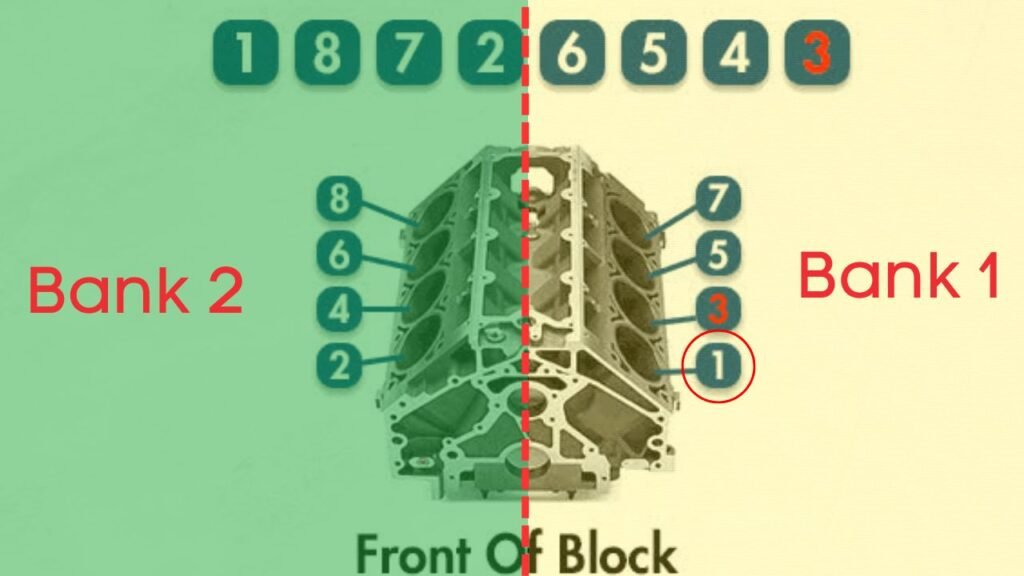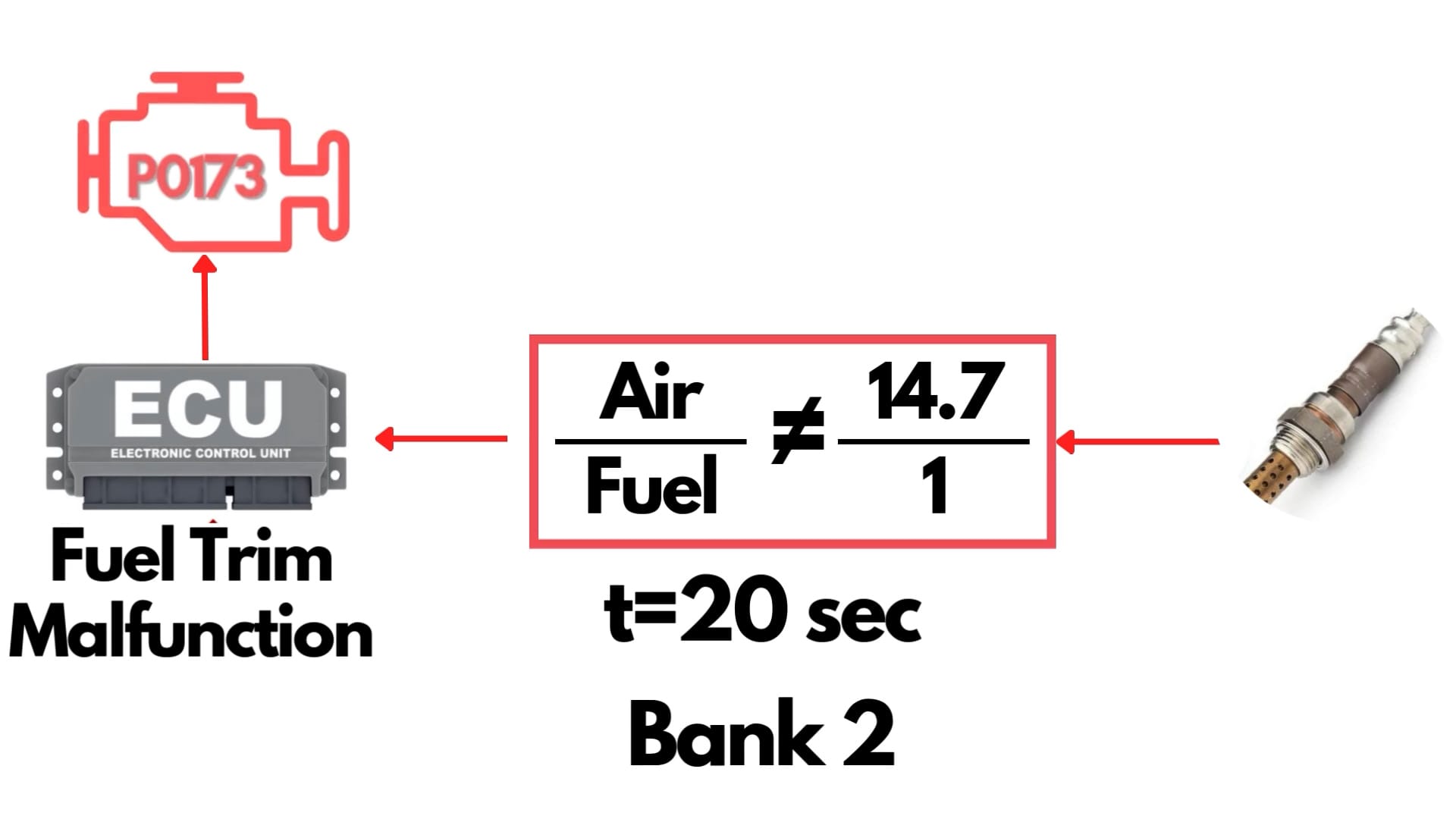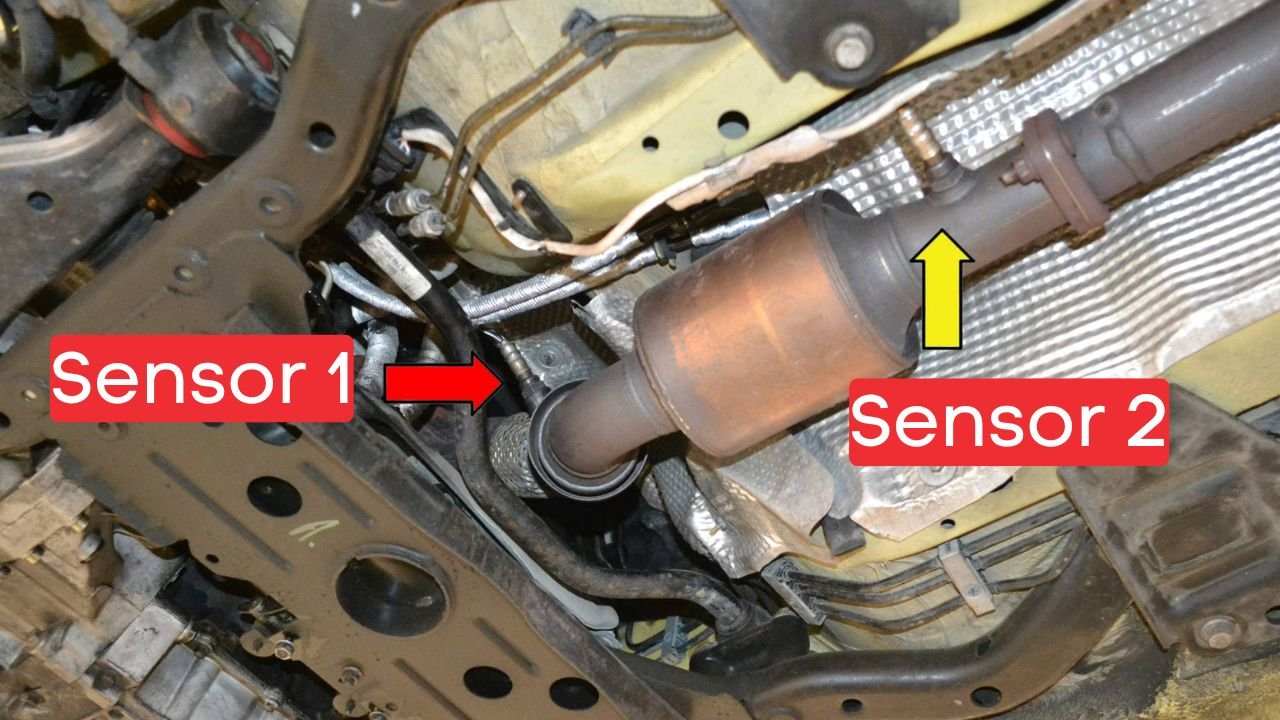How To Fix P0173? | Fuel Trim Malfunction on Bank 2
When you purchase through links on our site, we may earn an affiliate commission. See our affiliate disclaimer for more information.
What does the P0173 Fuel Trim Malfunction (Bank 2) mean?
P0173 code gets triggered when the Engine Control Module receives an input signal from the oxygen sensor—also called the air-fuel ratio sensor—indicating that the air/fuel mixture has been running too rich or too lean for an extended period of time, typically about 20 consecutive seconds.
Now, let’s talk specifics. A lean mixture means insufficient fuel and too much air in the combustion process, and, a rich mixture means too much fuel and insufficient air in the combustion process.
Both lean or rich mixture can lead to poor engine performance, increased emissions, and potential damage over time.
When this happens on Bank 1— the ECM flags it as a problem and triggers the P0173 trouble code.
What is Bank 2?
In engines with multiple cylinder banks, like V6 or V8 engines, you’ll have two sides or “banks” of cylinders. Bank 1 typically refers to the side of the engine where cylinder 1 is located, and Bank 2 is on the opposite side.

When the P0173 Triggers?
In a fully functional system, the upstream oxygen sensor, also called the air-fuel ratio sensor, measures the amount of oxygen in the exhaust gases as they leave the engine. This real-time data helps the Powertrain Control Module (PCM) adjust the air-fuel mixture for optimal performance.
For gasoline engines, the ideal air-fuel ratio is 14.7 parts air to 1 part fuel—this is known as the stoichiometric ratio. When the mixture is at this ratio, combustion is efficient, and emissions are minimized.
But when the oxygen sensor detects that the air-fuel ratio is either greater or lesser than 14.7:1—meaning fuel trim is either too rich or too lean—the PCM interprets this as a ‘Fuel Trim Malfunction.
If this condition persists for about 20 consecutive seconds, the PCM triggers the P0173 code, indicating that the system on Bank 2 is running either too lean or too rich.

Where is the P0173 Sensor or Oxygen Sensor Located?
The P0173 sensor, also known as the Oxygen Sensor or Air-Fuel Ratio Sensor, is generally located in the exhaust system, upstream of the catalytic converter on Bank 2. This sensor position can vary slightly depending on your vehicle’s make and model, but it’s usually found near the exhaust manifold.

How To Fix P0173?
Troubleshooting P0173 involves several steps, and we’ll discuss each one in detail. Let’s get started!
Before diving into specific repairs, perform an OBD-II scanner reset to clear the codes. Sometimes, these codes pop up due to recent maintenance work and can resolve themselves after a reset.
To reset the error codes, use an OBD-II scanner. Simply connect the scanner to your vehicle, follow the instructions to clear the trouble codes, and see if the P0173 code reappears.
If the code comes back, it means there’s a persistent issue that needs further troubleshooting.
Possible Root Causes of P0173
Some common root causes of the P0173 error code include:
1. Faulty oxygen sensor
The oxygen (O2) sensor measures the oxygen content in the exhaust and helps the ECU determine whether the engine is running rich or lean. If the O2 sensor itself is faulty, it can send incorrect signals to the ECU. This can lead to improper fuel trim adjustments and trigger the P0173 code.
Fix: Test the oxygen sensor using a scan tool or multimeter. If faulty, replace the sensor to restore proper fuel trim readings and reset the code.
- 【REPLACE#】15716, 15717, 15718, 15719, ZZC318861, XR3Z9G444CA, 15664, 234-4401, 234-4046. IF THE PLUG OF THE O2 SENSOR IS…
- 【PREMIUM QUALITY】Durability matters, that is why our o2 sensor is crafted from high temperature resistant material for q…
- 【HIGH PERFORMANCE】A defective or sluggish oxygen sensor can cause a variety of issues, like decreased engine performance…
2. Dirty or Faulty MAF Sensor
The Mass Air Flow (MAF) sensor measures the amount of air entering the engine. The ECU uses this information to calculate fuel injection timing and maintain the correct stoichiometric air-fuel ratio (ideal combustion balance).
If the MAF sensor is dirty or faulty, it may provide inaccurate readings. This causes the ECU to inject either too much or too little fuel, disrupting the air-fuel mixture and potentially triggering the P0173 code.
Fix: Before replacing the MAF sensor, try cleaning it with a dedicated MAF sensor cleaner. If cleaning doesn’t solve the problem, replacement may be necessary.
- Gumout Professional Formula Mass Air Flow Sensor Cleaner Safely Cleans Gas and Diesel MAF Sensors Restoring Sensor Funct…
- Deep Cleans GDI (Gasoline Direct Injection) / PFI (Port Fuel Injection) Intake Valves, As Well As, The Throttle Body, In…
3. Vacuum Leak Downstream of the MAF Sensor
If there is a vacuum leak downstream of the MAF sensor, unmetered air can enter the intake system. Since this extra air isn’t measured by the MAF sensor, the ECU doesn’t account for it when calculating the air-fuel mixture.
This leads to an incorrect fuel trim (usually a lean condition), which may cause poor performance and can trigger the P0173 code.
Fix: Inspect all vacuum hoses, PCV valve, and intake manifold gaskets for cracks, tears, or loose connections. You can also use a smoke leak detector to quickly and accurately detect hidden leaks.
- HyperSmoke Technology – Creates Thick Visible Smoke for Easy Leak Testing. Adjustable Pressure. Infinite Smoke. Instant …
- HyperSmoke Benefits – Hypersmoke never overheats, has EVAP mode to protect EVAP from permanent damage, has a mode with h…
- Includes Everything You Need – Made for ALL Leak Testing Scenarios – EVAP, Vacuum, Intake, Exhaust, Turbo, Superchargers…
4. Clogged or Failed Fuel Injector
The ECU sends commands to the fuel injector to deliver fuel into the cylinder. The injector’s timing and pulse width determine the exact amount of fuel injected.
If the fuel injector is clogged, sticking, or malfunctioning, it may fail to inject the correct amount of fuel as calculated by the ECU. This imbalance can disrupt the air-fuel ratio and trigger the P0173 code.
- [Vehicle Fitment-1]: Compatible with Jeep Grand Cherokee 2011-2015, Wrangler 2012-2017; Compatible with Ram 1500 2013-20…
- [Vehicle Fitment-2]: Compatible with Chrysler 200 2011-2017, 300 2011-2019, Town & Country 2011-2016; Compatible with Do…
- [Reference Number]: 800-2183N, 8002183N, 5184085AD, 05184085AC, 4G2269, 0280158233, FJ1147
5. Clogged or Dirty Fuel Filter
A clogged or dirty fuel filter can restrict the flow of fuel to the engine, resulting in low fuel pressure. When fuel delivery is insufficient, the ECU may struggle to maintain the correct air-fuel ratio, which can lead to improper fuel trims and trigger the P0173 code.
Fix: Replace the fuel filter as per the manufacturer’s maintenance schedule.
- Helps prevent dirt, rust, and other fuel contaminants from entering the fuel delivery system
- Some GM Genuine Parts may have formerly appeared as ACDelco GM Original Equipment (OE)
- GM Genuine Parts are designed, engineered and tested to rigorous standards, and are backed by General Motors
6. Leaking or Damaged Exhaust Components.
Cracks or leaks in the exhaust manifold, catalytic converter, muffler, or exhaust pipes can cause false sensor readings.
Check visually for leaks in the exhaust system. For small leaks, you can use MufflerSeal (an iron-reinforced paste) or similar products to seal joints and cracks.
- J-B Weld Muffler Seal: MufflerSeal is an iron reinforced paste designed to seal mufflers, pipe joints and exhaust system…
- Cure Process: MufflerSeal can cure in two ways: By allowing the product to fully harden after it has been applied which …
- Projects: Mufflers, Pipe Joints and Exhaust Systems.
Symptoms of the P0173 Code
Symptoms associated with P0173 can include:
- Illuminated Check Engine Light.
- Lack of Engine Power.
- Rough or Rolling Idle.
- Hesitation on Acceleration.






